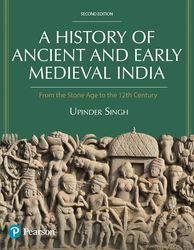Most history buffs have been mystified by the Harappans' script, their coinage, their state system—all of which we know little of. At the same time, we know a lot about their bricks, buildings, streets, products, exports and, of course, their sewage system. But what did the Harappans eat?
Few have asked that question, and fewer still have sought to answer it. This book, by one of India’s finest historians, asks the question and seeks to answer it. Upinder Singh says the Harappans ate wheat, millets, pulses, meat and dairy.
The dietary habits of the Harappans are only a small episode in this book, which is actually an exploration of Indian history until the late 12th century. The book delves into the rich tapestry of ancient and early medieval India, offering a comprehensive examination of its social, political, economic and cultural aspects. The author navigates through the complexities of the era, providing readers with a nuanced understanding of the historical landscape. The good thing is that she has presented these in a well-organised, chronological manner. In short, it is not a boring sociological account of the past, but a depiction of ancient India’s human drama.
The book stands out for its ability to strike a balance between being comprehensive while maintaining a level of intricacy. The inclusion of fresh research, notable sites, credible sources and thought-provoking theories further enriches the overall reading experience.
The original edition of the book had garnered praise from history enthusiasts, educators, scholars and students alike. The second edition includes the latest findings and advancements. The author also emphasises the significance of modern technology in archaeology. Through such discussions, the author gives deep insights into the significance of Attirampakkam (Tamil Nadu) in pushing the date of Stone Age of India earlier than 1.3 million years ago. She also vividly describes the amazing commercial network maintained by the Harappans that procured and distributed raw materials for their craft. This description is backed by provenance analyses of minerals, the discovery of megafauna like rhinoceros existing in the western part of India during 3rd millennium BCE, which are depicted in Harappan seals. You also get to know of the dates of earliest rice cultivation at Lahuradeva (Uttar Pradesh) touching 7th millennium BCE, as also about the exciting excavations of Ai-Khanoum in Afghanistan (which Sylvain Levy believed was the Alaknanda of ancient Indians), which revealed connections of post Mauryan India with parts of Afghanistan and so on.
In this edition, the author also gives a renewed focus to the eastern region, delving into its early history, empires and state formations. She also explores Neolithic traditions, such as megalithism, which have endured to this day in the region.
There is also much discussion on the science and mathematics found in ancient texts, which have become topics of great interest these days. The book broadens its scope to encompass various regions of south Asia, going beyond India and giving insightful sections on Buddhism in the Maldives and the Mesolithic era in Sri Lanka.
Overall, the book effortlessly guides readers through the complex historical landscape while refraining from oversimplification. The reader's comprehension is enriched by the inclusion of visual elements like maps, illustrations and timelines, along with fresh visuals and an updated design. Singh provides a comprehensive and nuanced exploration of India's history, presenting a well-rounded perspective that incorporates a diverse range of sources.
A History of Ancient and Early Medieval India: From the Stone Age to the 12th Century (second edition)
By Upinder Singh
Published by Pearson, 2024
Price Rs1,999 (hardbound); pages 817


